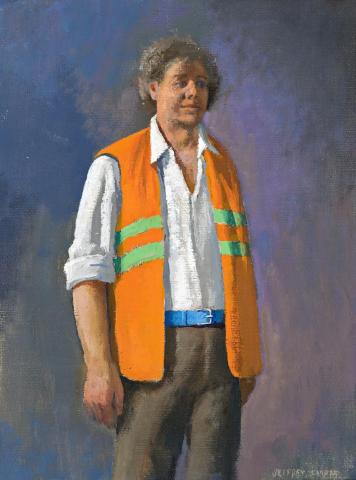FIGURE STUDY FOR 'VIA PIERO DELLA FRANCESCA', 2007
JEFFREY SMART
oil on canvas on board
36.5 x 27.0 cm
signed lower right: JEFFREY SMART
Philip Bacon Galleries, Brisbane, acquired 2008
The K.D.H. Ainsworth Collection, Queensland
Jeffrey Smart, Philip Bacon Galleries, Brisbane, 15 April - 10 May 2008, cat. 21A
Jeffrey Smart's studies in oil are as fascinating as his finished paintings, these steps in the creative journey often revealing more about the process and the artist than the final work. Figure Study for 'Via Piero della Francesca' of 2007 is such a work, seemingly unused and unrelated to what eventuated. But then we all know that Smart is a master of the enigmatic and not everything appears to be as straightforward as it might seem. Smart said that he introduced figures into his compositions for purposes of scale. So be it. But that is not all; and Smart has referred to 'the glorious human body', which all artists must learn to draw as an essential part of their equipment.1 The Via Piero della Francesca is another reference of more than casual interest. Streets of this name are found in Milan, Rome and Arezzo, the latter close to where Smart lived in the countryside for much of his creative life. They honour the great Italian Early Renaissance artist who Smart loved, and whose fresco cycle the Legend of the True Cross is found in Arezzo's church of San Francesco. Friends never forget the experience of being given a guided tour by Smart of the fresco series, enveloped in his enthusiasm. One of Smart's favourite paintings was Piero's The Flagellation, c1448-1450.2 He liked it so much that he once remarked, 'I have a copy of it in the bathroom of my villa and another pinned on the wall of my studio. It is never far from my sight.' Then he added, 'It is almost perfectly designed.'3 Perfect design was Smart's holy grail. In his own words, he always wanted 'to get the composition right'.4 Moreover, Smart and Francesca shared the enigmatic.
Compare Via Piero della Francesca with The Flagellation and teasing compositional and other affinities, emerge. In spatial terms, the foreground bulk of both is contrasted with the recessional left. Figural references are more subtle - the figure of Christ at the column, for example, transforms into the female figure in blue shorts in Smart's painting. They share a narrative silence. And our figure study? Compare it with Piero's figure in red. Some reversals and change of clothing are allowable to give a contemporary look. Smart and Francesca celebrated excellence within the eloquence of silence.
1. Smart, J., 'On Drawing', Jeffrey Smart Exhibition of Drawings, Watercolours and Studies, Philip Bacon Galleries, Brisbane, 2003, unpaginated
2. In the collection of the Galleria Nazionale delle Marche, Urbino, Italy
3. Smart, J., quoted in Capon, E., and Greer, G., Jeffrey Smart: Drawings and Studies 1942-2001, Australian Galleries, Sydney 2001, p. 33
4. ibid, p. 148
DAVID THOMAS
